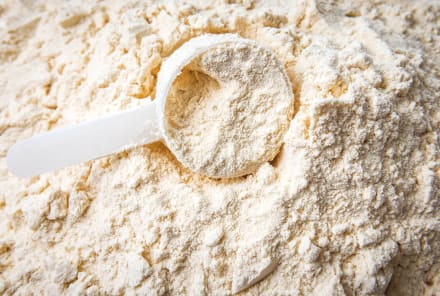Advertisement
How Eating For Stable Blood Sugar Helped My Endometriosis Symptoms


When I was 21 and wrapping up my undergraduate degree in journalism, I had just landed my first big reporting assignment for a television station. But while on assignment, I had to keep running to the bathroom to take deep breaths, loosen my waistband, and brace myself against a stall door to work through debilitating menstrual cramps. At least that's what I thought I was experiencing.
At the urging of my mother, I later went to my OB/GYN. He performed exploratory laparoscopic surgery1 to determine I had endometriosis.
The pain I was enduring resulted from internal bleeding and tissue cramping. The diagnosis explained why my periods (and many other days throughout my cycle) often left me in tears.
Even though my doctor at the time performed ablation surgery2 on my endometrial lesions, my pain did not resolve. So I went back to the doctor. He told me I should just get pregnant.
His misguided and illogical reasoning was that pregnancy would stop me from menstruating. But, as we all know, pregnancy is temporary. I scoffed at his ridiculous solution. I had big plans to go to grad school and zero plans of having children. The idea that getting pregnant is a cure for endo is now widely known as a myth3—and a misogynistic one at that.
Endometriosis and diet.
Fast-forward a good 20 years, and we still don't have a cure for endo, and we don't have what I, or the World Health Organization4 for that matter, would consider effective treatments for the condition.
But I'm not surprised. In 2022, the National Institutes of Health dedicated less than 0.1% of their research funding to the study of this chronic condition that affects 1 in 105 people assigned female at birth of reproductive age, significantly reduces quality of life6, and costs the United States an estimated $22 billion a year in lost productivity. (FYI, in rare cases, people assigned male at birth can have endo too.)
Like many people with endo who've been left in the lurch regarding treatment and care, I had to do my own research. I discovered that dietary changes, although not a cure, may help alleviate endometriosis symptoms. Back in the early aughts, the prevailing wisdom regarding diet and endo was to go vegan.
The simplified theory was that eating some animal products7, like red meat, could drive prostaglandin production. Prostaglandins, although crucial for the body, when overproduced can cause the uterus (and that endometrial-like tissue) to contract, leading to pain and cramping. Plus, prostaglandins are implicated8 in the pathophysiology of endo.
As someone who went vegan way back in 2001, I can tell you that a vegan diet does not always equate to a healthy diet. Although I ate an abundance of fruits and veggies, I was also consuming lots of processed carbs, such as pasta, rice, cereal, bread, etc. So that vegan diet didn't necessarily help me. In fact, it may have made it worse9.
Like many people with endo who’ve been left in the lurch regarding treatment and care, I had to do my own research.
After my failed attempt at veganism, I became curious if eating for healthy and stable blood sugar levels might be a better way to manage endo symptoms.
The connections between endo and metabolic health.
As a medical journalist, I do a lot of writing and related research regarding metabolic health. And I've learned quite a bit about glucose (blood sugar) and insulin levels and how they affect or drive many medical conditions. Could endo be one of them?
I started looking for answers by scouring for studies looking at the direct connection between glucose levels and endometriosis. No large-scale studies have looked at direct links. But I found research supporting the concept that focusing on metabolic health, which includes stabilizing blood sugar, could help ease endo symptoms in a few key ways:
Endometriosis, blood sugar, and inflammation
First, it helps to understand some of what endometriosis growths do. They secrete pro-inflammatory cytokines10.
Cytokines are proteins that cells release; they can either be pro-inflammation or help reduce inflammation. Specifically, endometrial growths secrete interleukin-1β and tumor necrosis factor-α—though there are more. IL-1β and TNF-α11, as they are known for short, also impact nociceptor sensory neurons12 that detect potential threats and lead to the sensation of pain. Endometrial growths also increase Cyclooxygenase-210. COX-213 is an enzyme also implicated in pain.
When you pop that ibuprofen capsule or tablet to ease a headache, the inhibition of COX-2 is how those nonsteroidal anti-inflammatory medications work. COX-2 overexpression in the body is a risk factor for the recurrence of endometriosis14 after surgical removal. Endometriosis has links to a host of autoimmune diseases15, and some researchers theorize that endo is itself an autoimmune condition16. However, it is currently not designated as one.
Now let's look at hyperglycemia, which is high blood sugar, and inflammation. Hyperglycemia drives the expression17 of pro-inflammatory cytokines. High blood sugar also increases COX-2 expression18. So theoretically, high blood sugar may be a driver of endo's inflammatory mechanisms. Additionally, some pro-inflammatory cytokines, including IL-1β and TNF-α, can contribute to insulin resistance19, perhaps leading to a vicious cycle, where endo and high blood sugar both impact each other.
Endometriosis and insulin resistance
Insulin is a hormone released by pancreatic cells in response to glucose entering the bloodstream. It signals cells to uptake glucose for energy. When the bloodstream is continually flooded with glucose—which can occur from consuming too many high-carb or processed-carb foods—the pancreas produces even more insulin to convince cells to absorb glucose. Over time, cells get overwhelmed and cannot take in any more glucose, so they stop responding to insulin's action. Hence insulin resistance.
Hyperinsulinemia, or a high insulin level, which is associated with insulin resistance, can also lead to low levels20 of sex-hormone-binding globulin. SHBG binds sex hormones20, controlling the amount of free or available sex hormones in the body. So a low SHBG level can lead to an increase in available estrogen.
Endometriosis is an estrogen-dependent condition10, meaning that endo is fueled by estrogen. Endometriosis growths contain estrogen receptors and aromatase10. Aromatase is an enzyme that instigates the conversion of androgens (like testosterone) into estrogen. This can lead to even higher levels of estrogen in the body, fueling endometriosis growths.
Endometriosis and adipokines
Endometriosis also interferes with the adipokines adiponectin and leptin21. Adipokines are cytokines produced in fat tissue. Endometriosis is linked to high leptin levels and low adiponectin levels.
Adiponectin22 is anti-inflammatory and helps with insulin sensitivity, while low levels of adiponectin are associated with insulin resistance. Over the long term, leptin helps regulate your energy intake and expenditure for weight maintenance. But hyperleptinemia, or high leptin levels, can cause leptin resistance, meaning your brain doesn't respond to its cues. Researchers theorize that hyperleptinemia23 contributes to insulin resistance.
Endometriosis and blood sugar swings
Fatigue24 is an oft-cited symptom of endometriosis. Wide swings in blood sugar can cause fatigue or worsen it. That's because a blood sugar spike can subsequently lead to reactive hypoglycemia. Reactive hypoglycemia25 is when the body overcorrects a blood sugar spike with an insulin surge. The insulin surge helps shuttle glucose into cells, removing it from the bloodstream and causing blood sugar to plummet. A blood sugar crash often causes fatigue.
How to eat for stable blood sugar.
More than two decades have passed since I was diagnosed with endometriosis. I've since had four additional laparoscopic surgeries to excise endometriosis lesions. None minimized my pain and bleeding. In 2017, I had a hysterectomy, keeping just one ovary. Although not an endometriosis cure, the hysterectomy dramatically helped me.
In 2021, I wore a continuous glucose monitor for one month. Doing so gave me valuable insights into how the foods I ate affected my glucose levels and helped me eat to stabilize my blood sugar. I believe that these dietary changes have also helped keep symptoms at bay.
Here are a few of the eating strategies I've found helpful for symptom management:
- Eliminate, as much as possible, added sugar26 and ultra-processed foods27. Both drive inflammation.
- Minimize glycemic variability, which drives pro-inflammatory cytokines. Blood sugar levels fluctuate throughout the day, based on various factors. But aiming to minimize blood sugar spikes, which are often followed by lows, keeps blood sugar levels more stable.
- Pair carbohydrates with protein, healthy fats, and fiber to minimize potential blood sugar surges. All three help slow glucose absorption into the bloodstream.
- Take a short walk after a meal. Exercising after eating helps blunt28 a post-meal blood sugar spike.
- Up your micronutrient intake29 by eating a rainbow of fruits and vegetables. Micronutrients are key for many metabolic processes and crucial for maintaining healthy cell functioning. Plus, fruits and veggies contain antioxidants30, which have anti-inflammatory effects, and they benefit your gut microbiome. Endo is linked with gastrointestinal issues.
- Add more omega-3 fatty acids and reduce intake of omega-6 fatty acids. Omega-3s are anti-inflammatory, while omega-6s can drive inflammation. In the U.S. many people consume31 more omega-6s than omega 3s. Reversing this ratio may help30 with endometriosis.
- Eat vitamin-D-rich foods. Low D levels30 are linked to an increased risk of endo as well as an increase in symptom severity.
- Boost fiber intake. Dietary fiber has been shown to reduce circulating estrogen7, which may help with endo.
- Reduce consumption of red meat and dairy. Red meat30 may promote inflammatory markers and increase estrogen levels. And the palmitic acid30 from dairy and meat may also boost estrogen, which could drive endometriosis progression.
Focusing on stabilizing blood sugar and eating anti-inflammatory foods have benefits that go beyond the potential for easing endo symptoms. Just consider the fact that less than 12% of people in the U.S. are considered metabolically healthy, and only 8% have optimal metabolic health.
The takeaway.
The painful symptoms of endometriosis might be eased by focusing on keeping blood sugar levels more stable via a diet that's low-carb, high in omega-3 fatty acids, and prioritizes fiber. That's because endometriosis is an inflammatory condition that high blood sugar, or even just blood sugar swings, may worsen.
Since starting to eat to stabilize my blood sugar, I feel better than I ever have. I hope future research explores the possible links between blood sugar and this chronic condition that steals quality of life from so many people assigned female at birth. I, for one, wish I'd had this information much earlier.
31 Sources
- https://pubmed.ncbi.nlm.nih.gov/34562632/
- https://journals.sagepub.com/doi/abs/10.1177/22840265221074850
- https://pubmed.ncbi.nlm.nih.gov/29471493/
- https://www.who.int/news-room/fact-sheets/detail/endometriosis
- https://www.nejm.org/doi/full/10.1056/NEJMra1810764
- https://pubmed.ncbi.nlm.nih.gov/28635533/
- https://www.frontiersin.org/articles/10.3389/fnut.2023.1089891/full
- https://pubmed.ncbi.nlm.nih.gov/22003899/
- https://pubmed.ncbi.nlm.nih.gov/35554558/
- https://www.mdpi.com/1422-0067/19/8/2385
- https://pubmed.ncbi.nlm.nih.gov/17426506/
- https://pubmed.ncbi.nlm.nih.gov/31855389/
- https://www.ncbi.nlm.nih.gov/books/NBK549795/
- https://journals.sagepub.com/doi/full/10.2217/whe.15.56
- https://www.nature.com/articles/s41598-021-94877-z
- https://pubmed.ncbi.nlm.nih.gov/31260048/
- https://journals.plos.org/plosone/article?id=10.1371/journal.pone.0220577
- https://www.ncbi.nlm.nih.gov/pmc/articles/PMC4731895/
- https://www.frontiersin.org/articles/10.3389/fendo.2019.00703/full
- https://pubmed.ncbi.nlm.nih.gov/23121642/
- https://pubmed.ncbi.nlm.nih.gov/33501880/
- https://pubmed.ncbi.nlm.nih.gov/24957699/
- https://www.cureus.com/articles/47751-association-of-leptin-with-obesity-and-insulin-resistance#!/
- https://pubmed.ncbi.nlm.nih.gov/29947766/
- https://pubmed.ncbi.nlm.nih.gov/32377086/
- https://www.cdc.gov/nutrition/data-statistics/added-sugars.html
- https://pubmed.ncbi.nlm.nih.gov/34261638/
- https://link.springer.com/article/10.1007/s40279-021-01473-2
- https://www.frontiersin.org/research-topics/46702/micronutrients-and-metabolic-diseases
- https://www.frontiersin.org/articles/10.3389/fnut.2023.1089891/full#B41
- https://pubmed.ncbi.nlm.nih.gov/26950145/
Watch Next
Enjoy some of our favorite clips from classes
Enjoy some of our favorite clips from classes
What Is Meditation?
Mindfulness/Spirituality | Light Watkins
Box Breathing
Mindfulness/Spirituality | Gwen Dittmar
What Breathwork Can Address
Mindfulness/Spirituality | Gwen Dittmar
The 8 Limbs of Yoga - What is Asana?
Yoga | Caley Alyssa
Two Standing Postures to Open Up Tight Hips
Yoga | Caley Alyssa
How Plants Can Optimize Athletic Performance
Nutrition | Rich Roll
What to Eat Before a Workout
Nutrition | Rich Roll
How Ayurveda Helps Us Navigate Modern Life
Nutrition | Sahara Rose
Messages About Love & Relationships
Love & Relationships | Esther Perel
Love Languages
Love & Relationships | Esther Perel

















